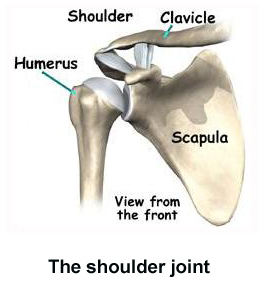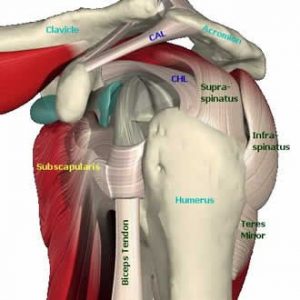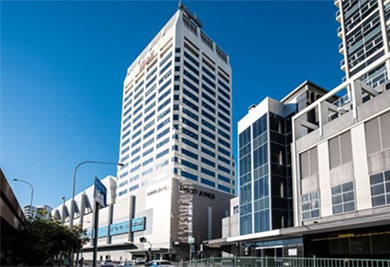What is Rotator Cuff Syndrome?
What is your Rotator Cuff?
Rotator cuff syndrome is very common shoulder injury. The subscapularis, supraspinatus, infraspinatus and teres  minor are your small rotator cuff muscles that stabilise and control your shoulder movement on your shoulder blade (scapula).
minor are your small rotator cuff muscles that stabilise and control your shoulder movement on your shoulder blade (scapula).
This group of muscles and their tendon are vulnerable to injury because of the mobility of the shoulder joint.
Rotator cuff injuries vary from mild tendon inflammation ( rotator cuff tendonitis), shoulder bursitis (inflamed bursa), calcific tendonitis (bone forming within the rotator cuff tendon) through to partial and full thickness rotator cuff tears, which may require rotator cuff surgery.
Where are your Rotator Cuff Muscles?

Your rotator cuff muscles hold your arm (humerus) onto your shoulder blade (scapula). Most the the rotator cuff tendons are hidden under the bony point of your shoulder (acromion), which as well as protecting your rotator cuff can also impinge into your rotator cuff structures.
What Causes a Rotator Cuff Injury?
Your rotator cuff tendons are protected from simple knocks and bumps by bones (mainly the acromion) and ligaments that form a protective arch over the top of your shoulder.
In between the rotator cuff tendons and the bony arch is the subacromial bursa (a lubricating sack), which helps to protect the tendons from touching the bone and provide a smooth surface for the tendons to glide over.
However, nothing is fool-proof. Any of these structures can be injured – whether they be your bones, muscles, tendons, ligaments or bursas.
What are the Symptoms of Rotator Cuff Injury?
While each specific rotator cuff injury has its own specific symptoms and signs, you can suspect a rotator cuff injury if you have:
- An arc of shoulder pain or clicking when your arm is at shoulder height or when your arm is overhead.
- Shoulder pain that can extend from the top of your shoulder to your elbow.
- Shoulder pain when lying on your sore shoulder.
- Shoulder pain at rest (in more severe rotator cuff injuries).
- Shoulder muscle weakness or pain when attempting to reach or lift.
- Shoulder pain when putting your hand behind your back or head.
- Shoulder pain reaching for a seat-belt.
How to Treat a Rotator Cuff Injury?
Researchers have concluded that there are essentially 7 stages that need to be covered to effectively rehabilitate these injuries and prevent recurrence. These are:
- Early Injury Protection: Pain Relief & Anti-inflammatory Tips
- Regain Full Range of Motion
- Restore Scapular Control
- Restore Normal Neck-Scapulo-Thoracic-Shoulder Function
- Restore Rotator Cuff Strength
- Restore High Speed, Power, Proprioception & Agility
- Return to Sport or Work
A specific range of exercises designed to strengthen and stretch the affected areas is required. ESWT Shockwave therapy is very effective in treating the pain of rotator cuff injury and increase the healing rate of the affected muscles and tendons. Your therapist will be able to guide you in the appropriate treatment and exercises for your rotator cuff injury after their thorough assessment.



